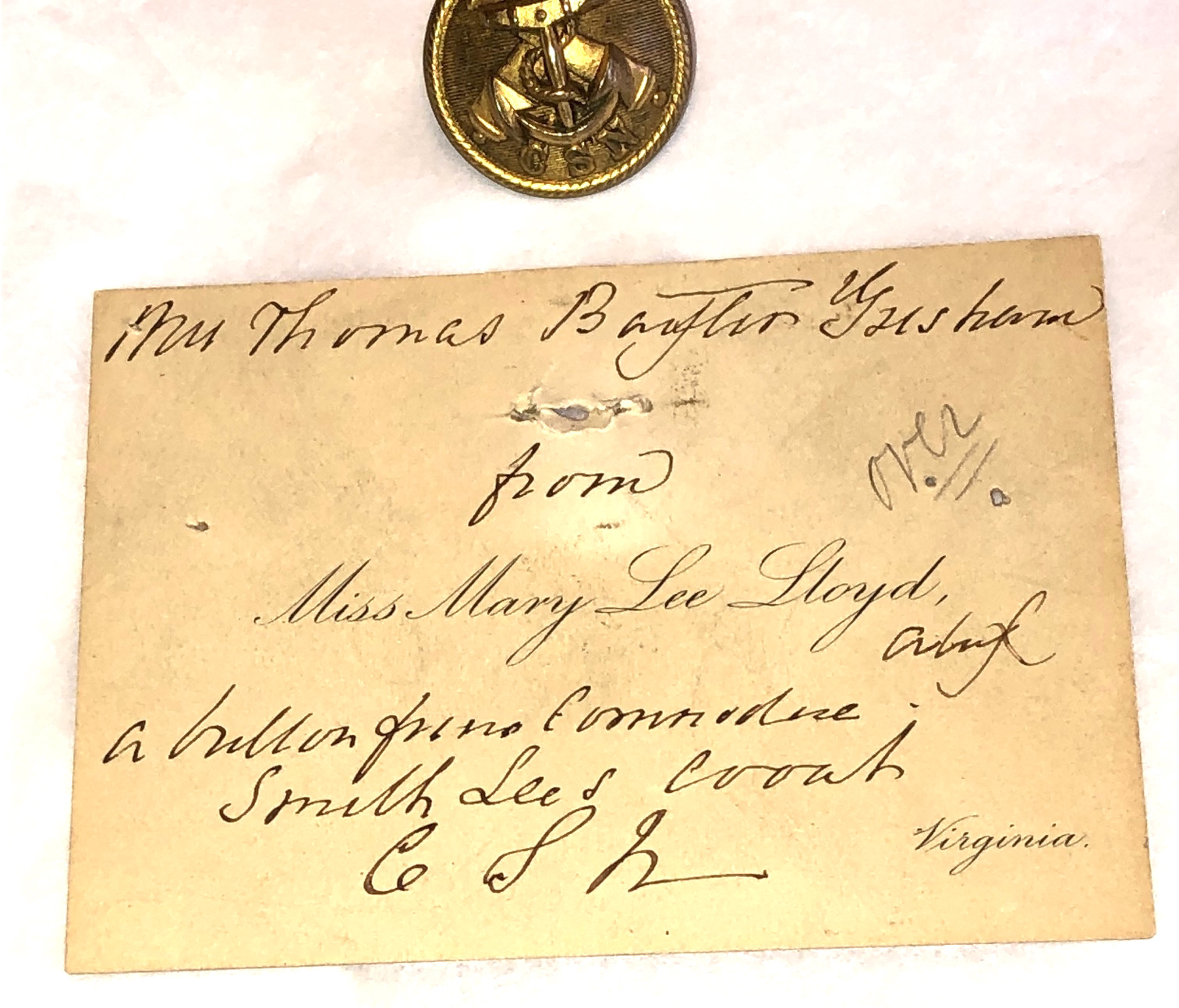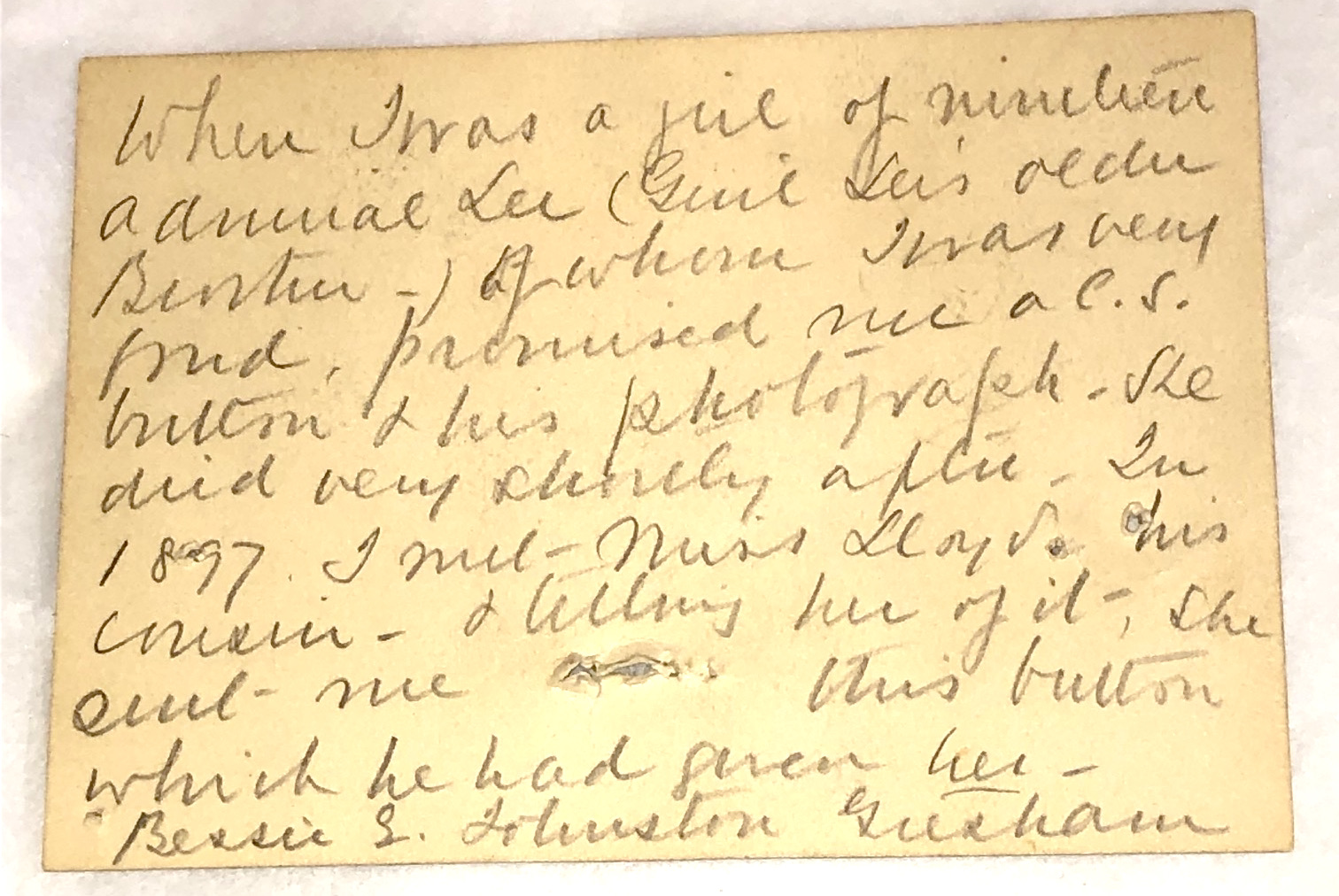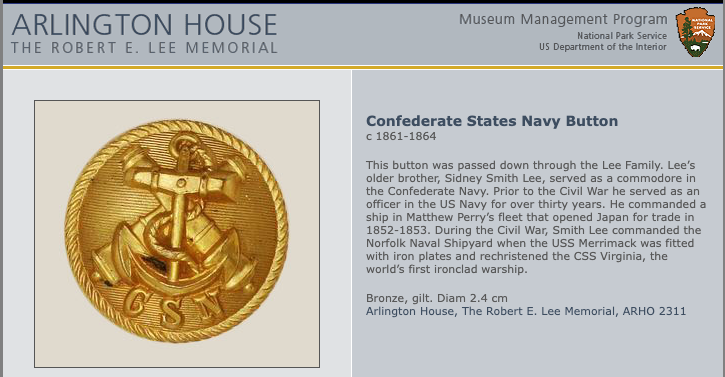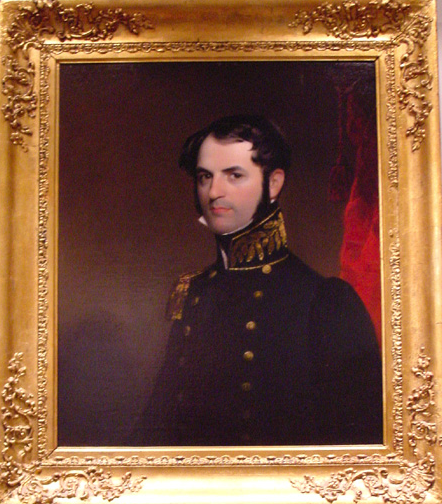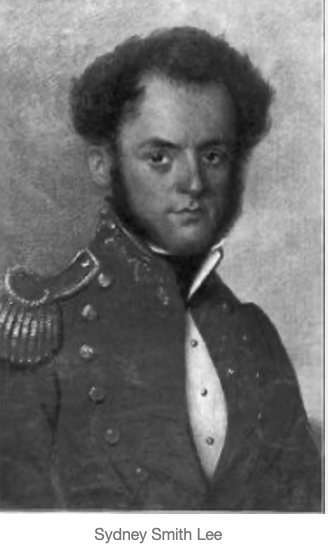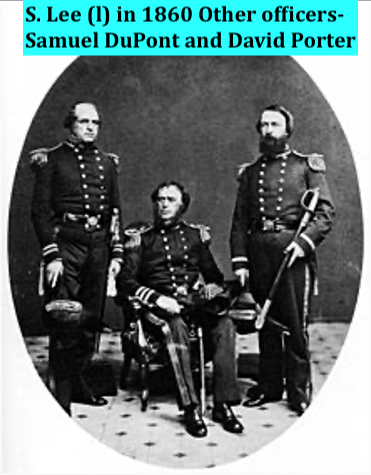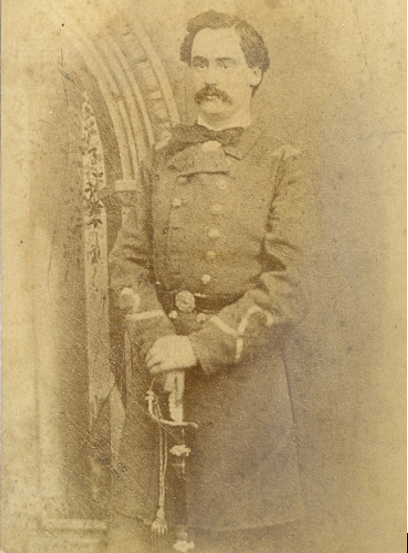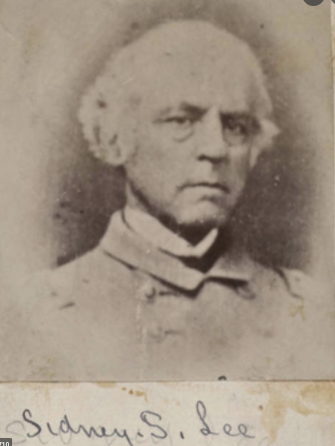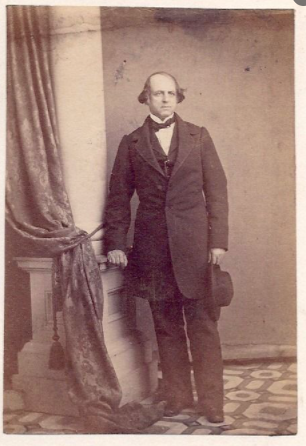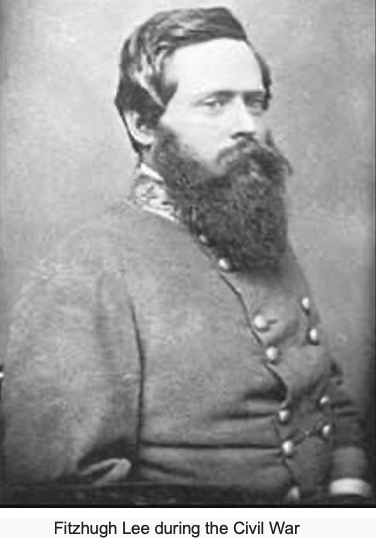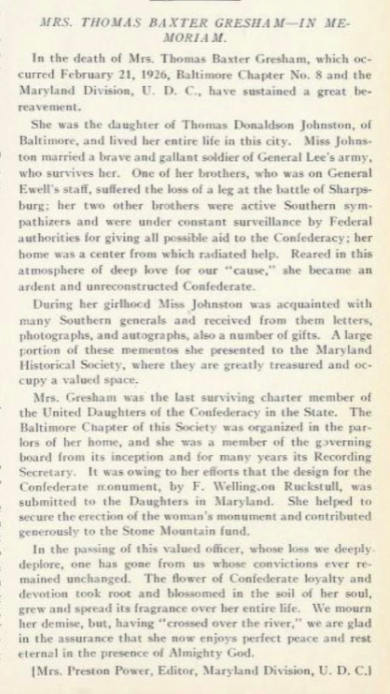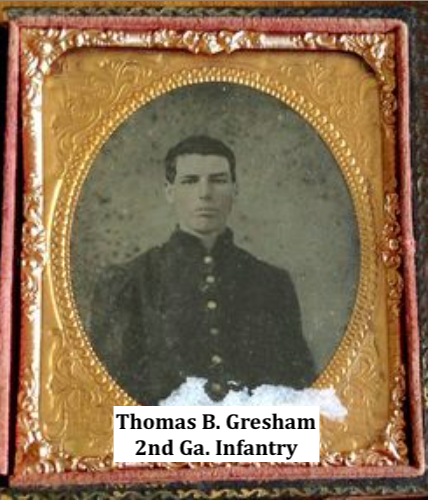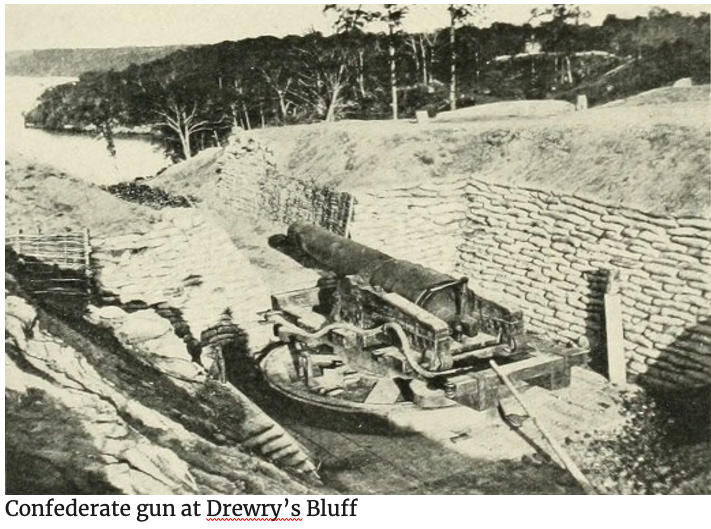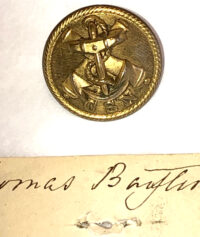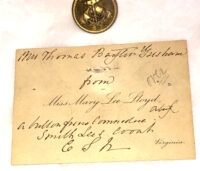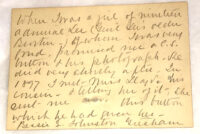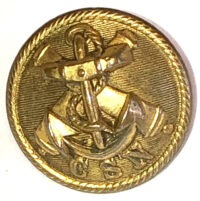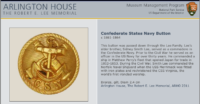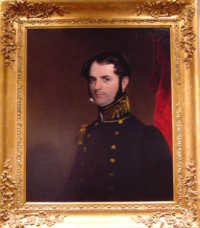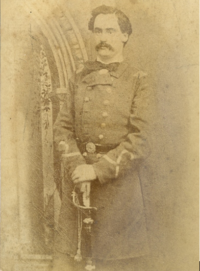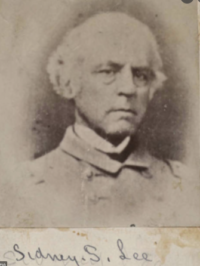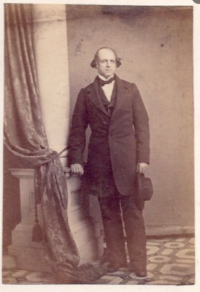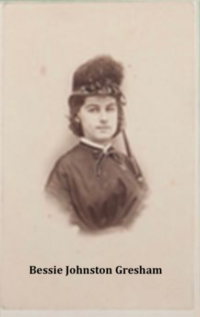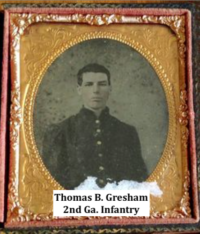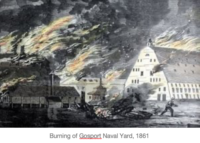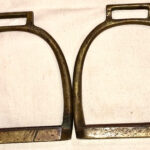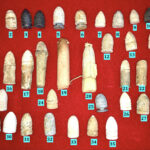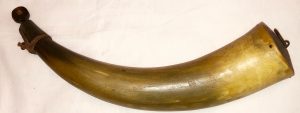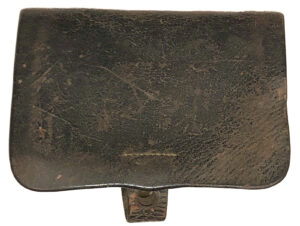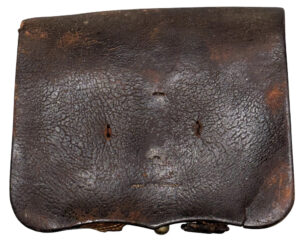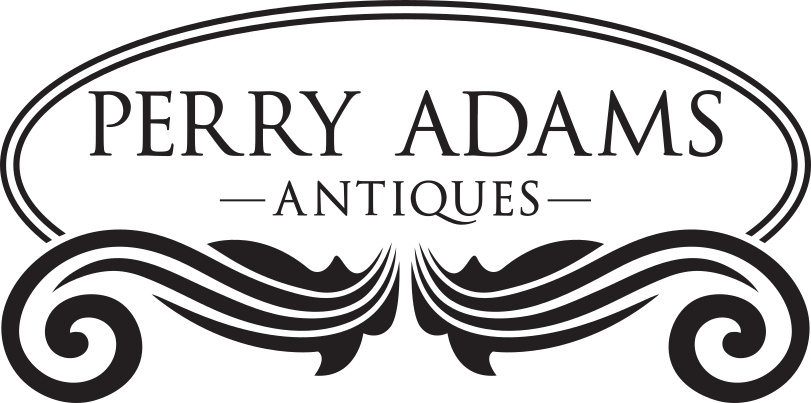Confederate Navy Coat Button from the Frock Coat of Captain Sidney Smith Lee – Older Brother of Gen. R.E. Lee
SOLD
Confederate Navy Coat Button from the Frock Coat of Captain Sidney Smith Lee – Older Brother of Gen. R.E. Lee – This Confederate navy, coat button (Firmin back marked) was from the wartime frock coat of Confederate Navy Captain, Sidney / Sydney Smith Lee, older brother of General Robert E. Lee. The button was gifted to Bessie Johnston Gresham, wife of a former Confederate Georgia infantry soldier and later lawyer, Thomas Baxter Gresham, in 1897, by Mary Lee “Minnie” Lloyd; “Minnie” Lee’s mother was a cousin of Robert E. Lee and wife of a successful citizen of Alexandria, Virginia, John Lloyd. Mrs. Gresham, a UDC member and strong supporter of the Confederate cause, was, according to her obituary (depicted in our listing), acquainted with several Confederate generals and wartime, military luminaries and an avid recipient and collector of memorabilia given by them, to her. The button had been, at some point in the distant past, affixed to a 19th century calling card, as indicated by the hole in the middle of the card, where the button’s shank had been inserted. On the front of the card is engraved the following:
“Miss Mary Lee Lloyd
Virginia”
Handwritten on the front of the card, in ink, is this inscription:
“Mrs. Thomas Baxter Gresham
From
(engraved – Miss Mary Lee Lloyd)
a button from Commodore
Smith Lee’s coat
CSN”
To the right of the word “From” is written and underlined: “Over”.
On the reverse side of the calling card is this more lengthy, hand written inscription:
“When I was a girl of nineteen
Admiral Lee (Gen’l Lee’s older
Brother) of whom I was very
fond, promised me a C.S.
button & his photograph. He
died very shortly after, In
1897 I met Miss Lloyd – his
cousin – telling her of it – she
sent me this button
which he had given her.
Bessie E. Johnston Gresham”
***An enumeration of all of the various people that are directly and tangentially named in regards to this button, is listed below.
The button remains in excellent condition; the slight tarnishing to the gilding and overall patina belie the fact that the button was one actually worn on Smith Lee’s war used coat; it can be specifically described as follows:
Confederate Navy button, English wartime manufacture. Backmark-Firmin120
Confederate Navy two part button. English wartime manufacture. Symbolism for Confederate Navy, anchor with fouled anchor, CSN, CN. Backmark: “FIRMIN & SONS / (dot) 153 STRAND LONDON (dot) / & 13 / CONDUIT. ST” dm middle solid ring, flat back, English wartime manufacture for the Confederacy. Two part button, large coat size, 22mm.
Research Center: Button8901-Confederate-Navy-Firmin120-CS52 . Reference: Albert CS52. Reference: Tice CSN202. Reference: Tice, Dating Buttons, page172, item 06. Plate C-1, 8. (Courtesy of Harry Ridgeway – Relic Man site)
Another of Sidney Lee’s CSN buttons is part of the collection maintained by the National Park Service at Arlington House, the Lee family home in northern Virginia. Note the picture of this button, essentially a duplicate of the button offered here, amongst the various images that are part of this posting.
The Less Famous Lee
Posted on January 11, 2014 by Caroline Davis
A devastated Robert E. Lee arrived too late for his older brother’s funeral in 1869. “A sad gap in our family… a grievous affliction to me which I must bear as well as I can,” he tearfully remarked to Mary, his wife.
Referred to simply as “Smith,” Sydney Smith Lee was known as the more handsome of the two Lee brothers. His nephew once said, “No one could be near my Uncle Smith without feeling his joyful influences.” This demeanor contrasted sharply with Robert’s proper, stoic attitude.
Both Lee brothers had a passion for their country. Robert found his place in the Army and Smith joined the Navy. Although Robert and Smith shared a remarkable military career, one went down in the history books and the other was all but forgotten.
An 18-year-old Smith left home in 1820 and entered the Navy as a midshipman thanks to an appointment by President Monroe. The next 40 years would look favorably on Smith. In 1828 he was promoted to Lieutenant. The only time Robert and Smith saw action together was during the Mexican-American War. “I stood by his gun when I was not wanted elsewhere here, I am at a loss what I would have done had he [Smith] been cut down before me. I thank God he was saved,” wrote General Lee about his experience during the Battle of Veracruz.
Smith’s role as commander of the Philadelphia Naval Yard along with his position at the US Naval Academy in Annapolis, MD boosted his reputation. His most famous accomplishment was his involvement in Matthew Perry’s expedition to Japan in the 1850’s. Smith was one of the first to anchor in Tokyo Bay (June 8, 1853). Perry’s expedition was considered a great success as it persuaded Japan to open its ports to world trade.
Smith was at the peak of his career when the Civil War began. Like most of his family, he did not want to see the nation divide. However, he had made a promise to stay true to his home state of Virginia. Smith turned in his resignation as soon as he heard that Virginia had decided to leave the Union. The Union dismissed him of duty five days later (April 22, 1861).
Smith later accepted a position as a commander in the Confederate States Navy (CSN). Despite a gallant effort, the CSN consisted of only 29 vessels and 9 captains by the fall of 1861. The Union Navy had more than eight times this amount. Undeterred, Smith took command of the once-thriving Gosport Shipyard in Norfolk, VA. Gosport was a strategic location on the banks of the Elizabeth River. One of the largest and most productive shipyards in the country, it was also one of the first two dry docks in America.
When Virginia seceded from the Union in 1861, the US troops stationed at Gosport feared they would be captured and withdrew to Union-held Fort Monroe. Before they left, they were ordered to burn the shipyard. As luck would have it, the Confederates were able to salvage quite a bit from the smoldering shipyard, including nearly 2,000 heavy guns that would prove useful throughout the war. Most importantly, they used the left-behind hull of the USS Merrimack to rebuild the Confederate Ironclad, CSS Virginia in 1862.
The shipyard was burned once again, this time by the Confederates, when the Union Navy forced them out. Smith was then promoted to captain and put in charge of the batteries at Drewry’s Bluffs, Virginia, where he would be second-in-command during a battle in May 1862. As a part of the Peninsula campaign, the Union Navy attempted to reach the Confederate capitol of Richmond, VA. Due to submerged obstacles in the James River and the Confederate defenses at Drewry’s Bluff, the Union was unable to reach Richmond and was forced to abandon the mission.
Captain Sydney Smith Lee took command of the site and supervised activities after the battle. Under his supervision, Drewry’s Bluffs expanded and became a permanent fort and an important training ground for the Confederate Naval Academy and the Confederate Marine Corps.
A year after the victory at Drewry’s Bluffs, Smith became the chief of the Confederate Navy Bureau of Orders and Detail. Replacing Captain John K. Mitchell, Smith remained at this post until the end of the war.
Smith lived for four pleasant years after the war, spending his time farming and visiting family. He died at his home in Richland, VA on June 22, 1869 at the age of 66.
Sydney Smith Lee
| Sydney Smith Lee | |
| Born | September 2, 1802 Camden, New Jersey, U.S. |
| Died | July 22, 1869 (aged 66) Richland, Stafford County, U.S. |
| Buried | Christ Church Episcopal Cemetery, Alexandria, Virginia, U.S. |
| Allegiance | United States Confederate States |
| Service/branch | United States Navy Confederate navy |
| Years of service | 1820–1861 (USN) 1861–1865 (CSN) |
| Rank | Commander (USN) Captain (CSN) |
| Commands held | USS Mississippi Gosport Navy Yard CSN Bureau of Orders and Detail |
| Battles/wars | Mexican War |
| Spouse(s) | Anne Marie Mason |
| Relations | Fitzhugh Lee (son) Henry Lee III (father) Anne Hill Carter (mother) Robert E. Lee (brother) |
Sydney Smith Lee (September 2, 1802 – July 22, 1869), called Smith Lee in his lifetime, was an American naval officer who served as a captain in the Confederate States Navy during the American Civil War. He was the third child of Henry “Light Horse Harry” Lee and Anne Hill Carter Lee, and the older brother of Confederate general Robert E. Lee.
Early life and education
Lee was born in Camden, New Jersey,[1] on September 2, 1802. At the age of 18 on December 30, 1820, he was appointed midshipman in the United States Navy and 8 years later promoted to lieutenant on May 17, 1828. During the Mexican–American War Lee fought in the Battle of Veracruz with his brother Robert E.; and afterwards was stationed there. He was promoted to commander on June 4. 1850 and accompanied Commodore Perry to Japan in 1853, commanding his flagship USS Mississippi.
Career
Commander Lee served as commandant of the U.S. Naval Academy and Philadelphia Navy Yard. He resigned from the service on April 17, 1861, the day Virginia declared it had seceded, though the resignation was not accepted. After dismissal on April 22, 1861, he accepted a commission as commander in the Confederate States Navy.
When the U.S. Navy abandoned the Gosport Navy Yard in Norfolk, Virginia, Commander Lee became the commanding officer there. When Union forces regained it, he was put in charge of batteries at Drewry’s Bluffs, Virginia. On May 6, 1864, he became chief of the Confederate Navy’s Bureau of Orders and Detail, replacing Captain John K. Mitchell. Lee was promoted to captain,and remained at this post until the end of the war.
Lee fought for the Confederacy reluctantly. As late as 1863 he denounced South Carolina for “getting us into this snarl” of secession, complaining that Robert and his family had persuaded him to act against his love of the U.S. Navy.[2]
Family and death
Lee’s wife was fellow Virginian, Anne Marie Mason (granddaughter of George Mason). One of their sons was Confederate Major General Fitzhugh Lee who later became Governor of Virginia, diplomat and writer; and served as Major General of U.S. Volunteers during the Spanish–American War. At least four more of his sons served in the Confederate States Army or Navy. After the war Lee became a farmer and died at his residence at Richland in Stafford County, Virginia on July 22, 1869.
John Lloyd also became a community leader, as a director of the Bank of Alexandria, director of the Fauquier & Alexandria Turnpike, and a trustee of the Alexandria Academy. Born of a lapsed Philadelphia Quaker family in 1775, Lloyd was an only child and orphaned when young. As a consequence, he was raised by his grandfather, Alexandria merchant and Revolutionary War veteran, Captain John Harper. In November 1798, Lloyd married Rebecca Janney, a 22- year-old Pennsylvania Quaker. Because Lloyd’s family had been dismissed from the Society of Friends, Rebecca too, was ejected from the Fairfax Quaker Assembly for a decade. The couple had seven children: John Janney (born 1800, died 1871); Nicholas Waln (born 1801, died as a child); Horatio Nelson (born 1804, died 1860); Selina (born 1807, died 1871); Alfred (born 1811, died 1812); Richard Henry (born 1815, died 1815); and Frederick (born 1817, died 1868). It is likely that only Richard and Frederick were young enough to still be residing with the family when they moved into what came to be known as the Lloyd House. The first Mrs. Lloyd never resided there either, as she passed away in 1817.
John Lloyd remarried in 1820, to the much younger Anne Harriotte Lee. Anne—daughter of attorney Edmund Jennings Lee and Sarah Lee, niece of Charles Lee and Light-Horse Harry Lee, and cousin of Robert E. Lee—was born in 1799 and grew up at her parents’ house, just two blocks north at 428 North Washington Street. The Lloyds first lived at 609 Oronoco Street, preceding as tenants Benjamin Hallowell’s first Alexandria school. The couple had six children: Edmund Jennings (born 1822, died 1889); Rebecca (born 1824, died 1873); Anne Harriotte (born 1826, died 1888); George Francis (born 1828, died 1866); Jean Charlotte Washington (born 1834, died 1914); and Mary Lee. The sources for Mary’s birthdate conflict; early census information and her obituary suggest that she was born between 1833 and 1835.
Mary Lee “Minnie” Lloyd
| BIRTH | 1833 |
| DEATH | 29 Aug 1921 (aged 87–88)
Washington, District of Columbia, District of Columbia, USA |
| BURIAL | Christ Church Episcopal Cemetery
Alexandria, Alexandria City, Virginia, |
“Minnie” died at the residence of her niece, Mrs. M. Crenshaw, in Washington, D.C. on August 29, 1921. She was buried the next day at Christ Church Episcopal Cemetery in Alexandria, Virginia.
Parents
John Lloyd
1775–1854
Ann Harriotte Lee Lloyd
1799–1863
| NAME: | Bessie E J Gresham | ||||||||||||||
| AGE IN 1910: | 60 | ||||||||||||||
| BIRTH DATE: | 1850 | ||||||||||||||
| BIRTHPLACE: | Maryland | ||||||||||||||
| HOME IN 1910: | Baltimore Ward 11, Baltimore (Independent City), Maryland, USA | ||||||||||||||
| STREET: | Park Ave | ||||||||||||||
| RACE: | White | ||||||||||||||
| GENDER: | Female | ||||||||||||||
| RELATION TO HEAD OF HOUSE: | Wife | ||||||||||||||
| MARITAL STATUS: | Married | ||||||||||||||
| SPOUSE’S NAME: | Thos B Gresham | ||||||||||||||
| FATHER’S BIRTHPLACE: | Maryland | ||||||||||||||
| MOTHER’S BIRTHPLACE: | Maryland | ||||||||||||||
| NATIVE TONGUE: | English | ||||||||||||||
| ABLE TO READ: | Yes | ||||||||||||||
| ABLE TO WRITE: | Yes | ||||||||||||||
| YEARS MARRIED: | 23 | ||||||||||||||
| NEIGHBORS: | View others on page | ||||||||||||||
| HOUSEHOLD MEMBERS: |
|
Bessie Elizabeth Johnston Gresham
| BIRTH | 1849
Baltimore City, Maryland, USA |
| DEATH | 21 Feb 1926 (aged 76–77)
Maryland, USA |
| BURIAL | Green Mount Cemetery
Baltimore, Baltimore City, Maryland, USA |
Family Members
Spouse
Thomas Baxter Gresham
1844–1933
Attorney born in Georgia. Married first Tallulah A. Billups. Married second Bessie E. Johnston.
Thomas B. Gresham
| Residence Bibb County GA;
Enlisted as a Private (date unknown).
He also had service in: “B” Co. GA 2nd Battn Infantry (Enlisted in 1863. Transferred to Engineer Corps in 1864)
|




